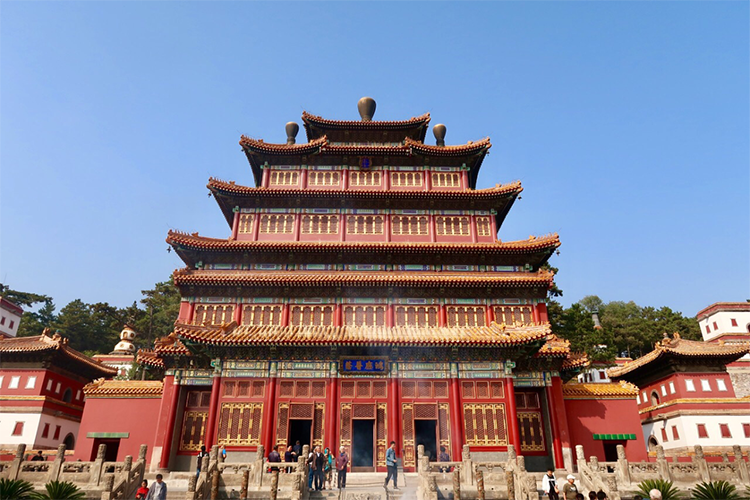Discover Puning Temple, Chengde: Tibetan Buddhism in China’s Mountain Sanctuary
1. Soul Temple: A Timeless Hall of Han‑Tibetan Buddhist Art
Northeast of Chengde’s Mountain Resort stands a gilded-roof temple that has quietly presided over the valley for 268 years — Puning Temple. One of northern China’s most magnificent Tibetan Buddhist monasteries, its entrance greets you with drifting incense, the metallic chime of prayer wheels and monks’ chants. Dominating the complex is a 22.28‑meter Thousand‑Armed Guanyin watching over devotees. A living museum and a UNESCO World Heritage site, Puning fuses Han rooflines and Tibetan mandala architecture, Qianlong’s imperial inscriptions and maroon-clad monks into a vivid story of Qing-era ethnic integration.
2. Echoes of History: From Qianlong’s Decree to World Heritage
In 1755 the Qianlong Emperor commissioned Puning to commemorate the suppression of the Dzungar rebellion, giving it the name that implies “universal peace.” As the only Outer Eight Temple still housing an active monastic community, Puning replicates the cosmic layout of Tibet’s first great monastery, Samye.
Three centuries of cultural significance:
– Religious status: An important Gelugpa (Yellow) school center where Dalai Lama and Panchen Lama historically preached.
– Architectural innovation: Pioneered a “front Han, rear Tibetan” layout that became a Qing royal temple model.
– Global recognition: Inscribed with the Mountain Resort as a UNESCO World Heritage site in 1994.
3. Decoding the Architecture: Han‑style Garan Meets Tibetan Mandala
3.1 Front Courtyard Han‑style Seven Halls (Garan Layout)
From the mountain gate along the central axis you’ll pass:
– Stele Pavilion: Qianlong’s Puning stele, scripted in Manchu, Chinese, Mongolian and Tibetan, heralding ethnic harmony.
– Hall of Heavenly Kings: Ming-style painted guardians with armor details that reveal Han craftsmanship.
– Mahavira Hall: A double-eaved xieshan roof sheltering the Three Buddhas; beams and palace-grade polychrome dragon motifs remain intact.
3.2 Rear Courtyard Tibetan Mandala (Three‑Dimensional Cosmos)
Passing the Dharma Wheel Hall, the scene shifts into a compact Buddhist cosmos:
– Great Vehicle Pavilion: The complex’s symbolic Mount Sumeru — outwardly Han in form, inwardly a Tibetan tantric mandala.
– Thousand‑Armed Guanyin: Carved from elm, pine and cypress, gilded with 120 taels of gold; 42 principal arms hold ritual implements, with a halo of myriad auxiliary hands.
– Four Continents Halls: Four fortress-like buildings in distinct colors representing the Buddhist continents; their arrangement echoes plateau and terrain patterns studied by geographers.

4. Immersive Experience: From Observation to Participation
Daily ritual highlights:
– 05:30 Morning prayers (viewable by visitors)
– 10:00 Prayer-wheel processions led by lamas in front of the Thousand‑Armed Guanyin Hall
– 15:00 Occasional debate sessions (more frequent in summer)
Participatory practices visitors can respectfully join:
1. Prayer wheels: Turn the outer ring of 108 wheels clockwise (never counterclockwise).
2. Offer a butter lamp: For about ¥10 at the Manjushri Hall; a lama may recite a short blessing.
3. Khata offering: White khatas sold on-site (¥20–50) can be presented before the main image.
5. Local Tips: How Locals Make the Most of Puning
Best times:
– Photographers: Arrive before 7:00 a.m. for golden rooftops and elders turning wheels in mist.
– Culture seekers: Volunteer Chinese-language guides offer free tours on Wednesday mornings; reserve at the visitor center.
– Avoid crowds: Peak group times are 10:00–14:00 on holidays.
Hidden gems:
– The small window on the second level of the Great Vehicle Pavilion offers the only full-frame view of the Thousand‑Armed Guanyin.
– A century-old bodhi tree on the east side of the white terrace bears bark patterns that naturally form a swastika-like character, a traditional Buddhist symbol.
6. Practical Visitor Handbook
Essential info:
– Address: No.1 Puning Road, Shuangqiao District, Chengde (1.5 km east of the Mountain Resort East Gate)
– Opening hours: Peak season (Apr–Oct) 08:00–17:30; Off-season 08:30–17:00
– Admission: ¥80 (includes deposit for the electronic guide device)
Getting there:
– Bus: Take routes 6 or 12 to “Puning Temple” stop.
– Car: South gate parking (¥10/hour; often full during peak season).
– Specialty transport: Horse-drawn replica carriages depart Lìzhèng Gate of the Mountain Resort (about ¥25 per person).
Etiquette reminders:
– Do not point at statues with an index finger; use an open-palmed gesture to indicate reverence.
– Ask permission and smile before photographing monks.
– Always turn prayer wheels and circumambulate stupas clockwise.

7. Cultural Connections: A One-Day World Heritage Loop in Chengde
Recommended classic route:
Morning: Puning Temple (2 hours) → Puyou Temple (5-minute walk to admire Han‑Tibetan murals)
Afternoon: Mountain Resort (enter via Chengguan Gate; focus on the miniature scenes of the Outer Eight Temples)
Deep-dive alternative:
Add Putuo Zongcheng Temple (the “Little Potala”) for a direct comparison of pure Tibetan and hybrid Han‑Tibetan styles.
From the Great Vehicle Pavilion’s platform at dusk, the golden roofs and distant qingqiu peaks glow in harmony. Puning is not simply a site to visit but a living classroom of China’s multi-ethnic unity. When you run your hand along a worn prayer wheel and feel the centuries of mantra beneath, you may understand: those 268 years of prayers travel beyond time and place.


